I’ve always loved the scene in the movie “Atlantis” when the princess’s necklace starts to glow. I remember begging my parents to visit Burger King just so I could get my very own! Little did I know back then that there were real glowing rocks out there in nature.
Glowing rocks and crystals are typically classified as either fluorescent or phosphorescent. These terms refer to the way a crystal’s structure and chemical composition react when exposed to UV light. Some varieties glow on their own after exposure, while others require a steady beam to continue glowing.
What are the different types of glowing crystals? What is the difference between fluorescence and phosphorescence? Keep reading to learn more!
What Are the Most Popular Rocks That Glow Under UV?
Rocks and crystals that glow in the dark are called phosphorescence and fluorescence. Both terms refer to the energetic dispersion of light from the crystal or rock. They usually occur due to an energizing reaction to radiation and light.
Phosphorescence comes from the term phosphorus, which is a combustible element that glows red. This element is an essential factor available in the various glowing rocks and crystals.
Some of the most popular rocks that glow under UV light include:
- Ruby
- Sapphire
- Chalcedony
- Various forms of quartz
- Fluorite
- Sodalite, such as Yooperlite
- Opal
- Apatite
- Agate
Some rocks glow in a phosphorescent process, such as sodalite and calcite. These rocks react to UV light and can glow for a short period on their own. These are rarer than fluorescent rocks but impressive to watch as they burn without a light or heat source.
Others, such as sapphire, quartz, and opal, are fluorescent. This means they reflect the light source and seem to glow under the UV light. However, once the light is removed, they cease to glow.
We will dive deeper into the luminescence process towards the end of the article. However, first, we will jump into the different types available and what they look like in UV light!
Top 5 List Of Rocks That Glow in UV Light
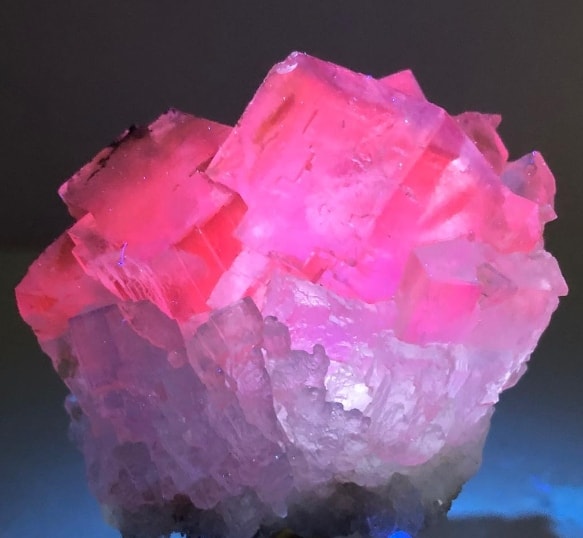
1. Fluorite
Fluorite, or fluorspar, is a calcium fluoride mineral that forms beautiful green, blue, and yellow crystals. This substance is also present in trace amounts throughout nature. It’s a key nutrient necessary for plant health, making it a common ingredient in fertilizers.
However, probably what it’s most known for is preventing tooth decay! Fluorite is one of the major ingredients in fluoride and is thus added to most toothpaste and mouthwash.
Fluorite is a fluorescent crystal. When exposed to ultraviolet light it glows a deep purple or lavender hue.
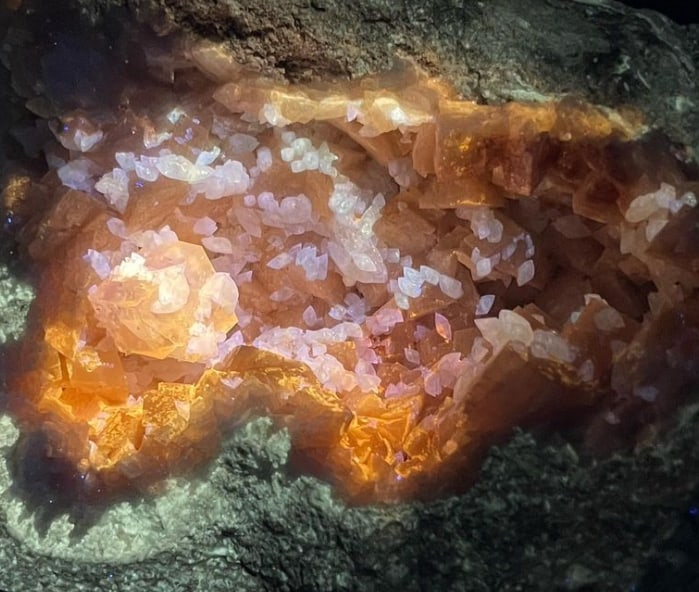
2. Calcite
Calcite is one of the most common rocks on Earth. It’s found in various rock layers. It’s used in a variety of building projects, including court buildings since it’s a key ingredient in marble and limestone. Calcite comes in both solid and translucent colorations. The solid variant is more commonly used in building projects.
Calcite is a form of phosphorescence. When exposed to UV light it can exhibit a variety of colors, including white, green, pink, and blue.
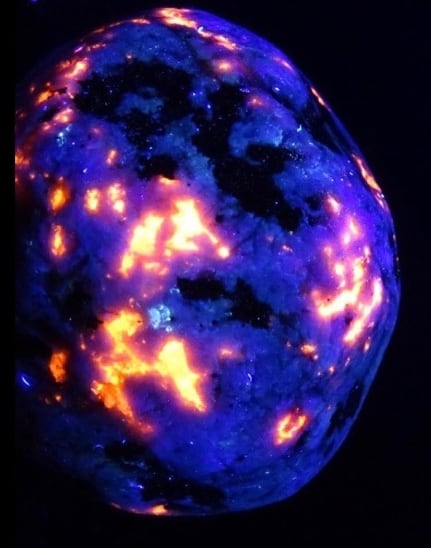
3. Sodalite
Sodalite is a form of feldspathoid rock. It’s extremely rare and has a deep, rich blue coloring. Most sodalite crystals are translucent, but some come in a more solid color variant.
The more solid-colored crystals cause them to resemble Lapis Lazuli. However, the two are very different and undergo different structural processes when forming.
The most popular variety of sodalite is sodalite-syenite. These crystals are also known by their trademark name, Yooperlite. These crystals are phosphorescence and glow a dark red or orange when exposed to UV light.
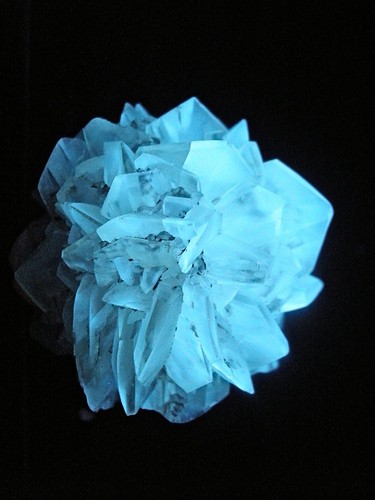
4. Selenite
Selenite is a beautiful variety of gypsum. While gypsum is a highly utilitarian rock, selenite is more commonly used for jewelry and spiritual healing.
The name “selenite” comes from the Greek word, “Selene,” which means “Moon” in ancient Greek. This name is meant to reflect this crystal’s beautiful, milky surface.
Depending upon the variety of selenite, the crystal can be either fluorescent or phosphorescent. They glow a soft yellow or bright green and blue when exposed to UV light.
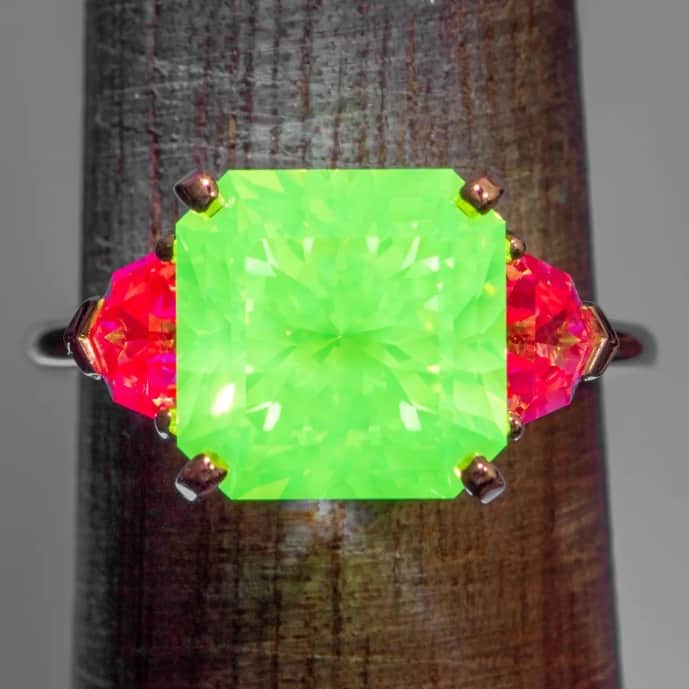
5. Corundum
Corundum is one of the hardest stones on Moh’s scale of hardness, ranking just below diamonds. Corundum comes in various forms and colors, but the most popular varieties are sapphire and ruby.
Sapphire and ruby both form in magma pits deep inside the Earth. The intense pressure they endure while crystalizing makes them one of the hardest rocks.
Corundum is a fluorescent crystal. Depending upon the variety you have this crystal can glow bright green or light blue when exposed to UV light.
What is the Causes Rocks to Glow Under UV Light?
Both fluorescence and phosphorescence are caused by the absorption of elements. When the atoms of a substance, such as a crystal, are exposed to radiation, they react through luminescence. The glowing after effect makes these glowing rocks so prized and sought after.
Phosphorescence is a form of irradiated elements. These elements typically glow a deep red or orange due to exposure to radiation or radiated materials. The heat is held within the element, causing it to glow for some time until the radiation cools.
The counterpart of this is fluorescence. Fluorescence occurs when energy from an element is excited from an external source. The most common form of this energy emission is with the fluorescent light bulb.
Both of these are a form of energy consumption and emission. However, they differ in how and why they emit light.
Phosphorescence emits light because it absorbs energy which leaves an afterglow. This glow persists as long as the heated elements remain warm or excited.
However, this form of glow doesn’t use the elements in the substance. Rather, it uses external elements which react with its atoms.
Fluorescence is a form of energy combustion that excites elements, causing them to burn. Thus, fluorescence only burns or glows as long as these elements persist. Once they disappear, the glow ceases.
Crystals and rocks can glow due to either of these processes. However, they often look different when glowing and glow for different amounts of time.
In general, both phosphorescence and fluorescence are a form of luminescence. However, phosphorescence can glow on its own accord for a period of time after being exposed. Fluorescence will cease to glow after the source is removed.
Conclusion
Glowing crystals are not a new phenomenon. There are several Medieval and ancient references to magical glowing stones which held special powers.
However, whether ancient peoples knew about these naturally occurring crystals is unknown. But, our fascination with the idea of a glowing crystal hasn’t waned over the years!
While you could take a rockhounding trip to Lake Superior and find your own, you don’t have to. Several Etsy stores provide legitimate crystals for your enjoyment.
- Identify Enstatite - March 12, 2024
- Identify Cerussite - March 3, 2024
- Identify Bytownite - February 18, 2024

2 Responses
Thank You, we are rock hounders as well and have noticed a lot of rocks and crystals glowing red under UV. Just trying to get a better understanding of what elements glow under UV. Thank you for your article. I have subscribed and am looking forward to your next write up. Is there a place to look for past articles about rocks and gems? Thanks again!
Nomi – Go to the bottom of the page, footer area. You’ll see a link to “sitemap”
It gives you a basic view on every article I’ve written so far.
Let me know if you’re looking for something in particular.